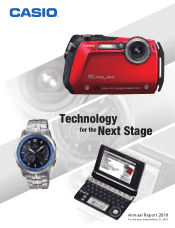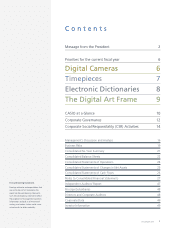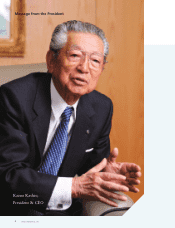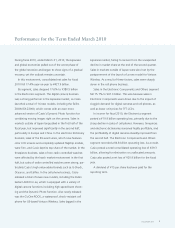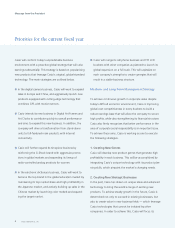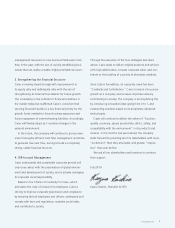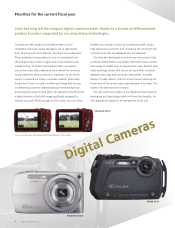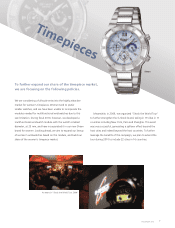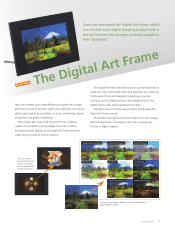Casio 2010 Annual Report Download - page 5
Download and view the complete annual report
Please find page 5 of the 2010 Casio annual report below. You can navigate through the pages in the report by either clicking on the pages listed below, or by using the keyword search tool below to find specific information within the annual report.
During fiscal 2010, ended March 31, 2010, the Japanese
and global economies pulled out of the worst phase of
the global recession and began to show signs of a gradual
recovery, yet the outlook remains uncertain.
In this environment, consolidated net sales for fiscal
2010 fell 17.4% year-on-year to ¥427.9 billion.
By segment, sales dropped 17.6% to ¥380.5 billion
in the Electronics segment. The digital camera business
was a strong performer in the Japanese market, as Casio
launched a total of 14 new models, including the Exilim
ZOOM EX-Z2000, which comes with an even more
advanced version of Casio’s Dynamic Photo function for
combining moving images right on the camera. Sales in
markets outside of Japan languished in the first half of the
fiscal year, but improved significantly in the second half,
particularly in Europe and China. In the electronic dictionary
business, sales of the EX-word series, which now features
color LCD screens and completely updated flagship models,
were firm, and Casio kept its top share of the market. In the
timepieces business, sales of non-radio controlled watches
were affected by the harsh market environment in the first
half, but sales of radio-controlled watches were strong, par-
ticularly Casio’s high value-added brands such as G-Shock,
Oceanus, and Edifice. In the cell phone business, Casio
released a total of seven new models, including the Exilim
keitai CA003 for au, which is equipped with a variety of
digital camera functions including high-speed burst shoot-
ing and the Dynamic Photo function. Also newly released
was the G’zOne ROCK, a waterproof, shock-resistant cell
phone for US-based Verizon Wireless. Sales lagged in the
Japanese market, failing to recover from the unexpected
decline in market share at the end of the second quarter.
Sales in markets outside of Japan were also hurt by the
postponement of the launch of a new model for Verizon
Wireless. As a result of these factors, sales were sharply
down in the cell phone business.
Sales in the Electronic Components and Others segment
fell 15.7% to ¥47.3 billion. This was because sales in
Electronic Components were down due to the impact of
sluggish demand for digital cameras and cell phones, as
well as lower unit prices for TFT LCDs.
In income for fiscal 2010, the Electronics segment
posted a ¥19.9 billion operating loss, primarily due to the
sharp decline in sales of cell phones. However, timepieces
and electronic dictionaries remained highly profitable, and
the profitability of digital cameras steadily improved from
the second half. The Electronic Components and Others
segment recorded a ¥4.8 billion operating loss. As a result,
Casio posted a total consolidated operating loss of ¥29.3
billion, allowing for elimination or unallocated amounts.
Casio also posted a net loss of ¥20.9 billion for the fiscal
year.
A dividend of ¥15 per share has been paid for the
reporting term.
Performance for the Term Ended March 2010
3
Annual Report 2010

